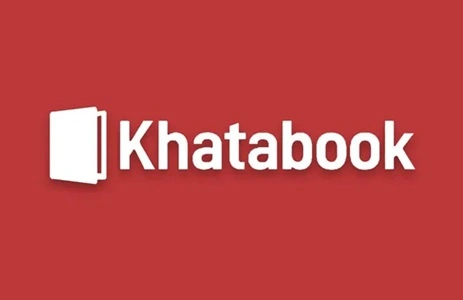Khatabook, a leading fintech startup in India, has revolutionized how small and medium businesses (SMBs) manage their accounts and financial operations. Founded in 2018 by Ravish Naresh, Dhanesh Hindocha, Aditya Prasad, and Vasanth Kamath, Khatabook started as a simple digital ledger app. It now serves as a comprehensive financial management platform for millions of businesses across the country.
This article delves into Khatabook’s business model, revenue streams, and strategies that have made it a key player in India’s fintech ecosystem.
Overview of Khatabook’s Business Model

Khatabook operates on a freemium model, offering essential financial management tools for free while monetizing through value-added services and premium features. The platform primarily caters to small businesses, shopkeepers, and traders, helping them digitize their financial transactions and streamline operations.
Key Features of Khatabook’s Business Model:
- Digital Ledger App:
- Khatabook allows businesses to record credit and debit transactions digitally, replacing traditional paper-based bahi khatas (accounting ledgers).
- Customer Management:
- The app helps businesses keep track of customer balances and send automated payment reminders via SMS or WhatsApp.
- Payment Solutions:
- Khatabook provides digital payment options, including UPI and QR code payments, enabling businesses to collect payments seamlessly.
- Data-Driven Insights:
- Users can access reports and insights to track business performance and financial health.
How Khatabook Earns Money
Khatabook has developed multiple revenue streams to monetize its platform while keeping its core services free for users. Here’s how the company earns money:
a. Subscription-Based Services
- Khatabook offers premium subscription plans with advanced features, such as:
- Analytics and Insights: Detailed reports on business transactions, trends, and customer behavior.
- Multi-Device Access: Premium plans allow users to sync data across multiple devices for better accessibility.
- Advanced Features: Features like inventory management, GST invoicing, and expense tracking are available for paid users.
- These subscriptions generate recurring revenue and cater to businesses that require more sophisticated tools.
b. Payment Solutions
- Khatabook facilitates digital payments through UPI, QR codes, and other payment gateways. It earns revenue by charging a small fee for certain payment transactions, especially for premium services or higher transaction volumes.
- The app also monetizes payment solutions by collaborating with financial institutions and earning a commission for each transaction processed through its platform.
c. Lending Services
- Khatabook has ventured into the lending space, offering business loans and working capital financing to its users. Revenue is generated through:
- Interest Income: Loans disbursed via Khatabook earn interest, a significant revenue stream.
- Commission from Lending Partners: The company partners with NBFCs (Non-Banking Financial Companies) and banks for loan disbursements and earns a commission on successful approvals.
d. Cross-Selling Financial Products
- Khatabook earns additional revenue by cross-selling financial products like:
- Insurance: Business insurance, health insurance, and other policies for SMBs.
- Investment Tools: Products like fixed deposits or mutual funds, offered through partnerships with financial institutions.
- Commissions from these sales contribute to its income.
e. Advertising and Partnerships
- The platform monetizes its extensive user base by offering advertising space to brands and financial institutions. For example:
- Sponsored banners or promotions for payment solutions, credit cards, or other financial services.
- Strategic partnerships with banks and fintech companies also generate revenue through co-branded campaigns and joint product offerings.
f. Value-Added Features
- Khatabook offers additional features as paid upgrades, such as:
- Data Backup and Recovery: Ensuring business data is securely stored and easily recoverable.
- Custom Branding: Allowing businesses to customize invoices and payment reminders with their logos and branding.
g. API Integration Services
- Khatabook provides API solutions for businesses that wish to integrate its services into their systems. These integrations are particularly useful for larger enterprises or SaaS providers and generate additional income.
Why Khatabook’s Model Works
Khatabook’s business model succeeds because it addresses the core pain points of SMBs in India while keeping its services simple and accessible. Here’s why it works:
a. Solving Real Problems
- The platform digitizes the traditionally manual process of recording transactions, helping businesses improve accuracy, reduce errors, and save time.
b. Freemium Model
- Offering free basic features attracts a large user base, which Khatabook monetizes through premium subscriptions and value-added services.
c. Accessibility
- The app is easy to use and available in multiple regional languages, making it accessible to India’s diverse SMB sector.
d. Ecosystem Approach
- By integrating digital payments, lending, and financial management, Khatabook has created a one-stop solution for small businesses, encouraging customer loyalty and engagement.
e. Technology-Driven
- Khatabook leverages AI and data analytics to provide personalized insights and recommendations, enhancing the value it offers to users.
Financial Performance
User Base
- Khatabook has over 10 million active users, primarily consisting of small business owners and shopkeepers.
Funding and Valuation
- The company has raised over $180 million from investors like Sequoia Capital, B Capital Group, and Tencent. Its valuation crossed $600 million in 2021, making it one of India’s top fintech startups.
Revenue Growth
- While Khatabook is still in its growth phase, its diversified revenue streams and focus on monetization through lending and premium features have contributed significantly to its revenue.
Challenges and Opportunities
Challenges
- High Competition:
- Competes with players like Vyapar, OkCredit, and traditional accounting software providers.
- Low Monetization in Free Users:
- A significant portion of its user base uses the free version, limiting revenue potential.
- Trust and Adoption:
- Convincing traditional businesses to adopt digital solutions remains a challenge in some regions.
Opportunities
- SMB Digitization Boom:
- India’s SMB sector is undergoing rapid digitization, offering significant growth potential for Khatabook.
- Lending and Financial Services:
- Expanding its lending and financial product portfolio can unlock new revenue streams.
- Global Expansion:
- Targeting SMBs in other emerging markets can drive growth.
- Integration with GST Compliance:
- Offering GST filing and compliance solutions can attract more users from small and medium enterprises.
Future Prospects
Khatabook is well-positioned to capitalize on India’s growing fintech landscape and the increasing digitization of SMBs. Key areas of focus for the future include:
- Scaling its lending and payment services.
- Enhancing its premium features to drive higher subscription revenue.
- Expanding its ecosystem through partnerships with banks, NBFCs, and SaaS providers.
- Strengthening its technological infrastructure for better user experience and scalability.
Conclusion
Khatabook’s business model combines simplicity, accessibility, and innovation to address the needs of India’s SMB sector. By offering free core features and monetizing through subscriptions, payments, lending, and partnerships, the platform has built a sustainable and scalable revenue model. As SMBs continue to embrace digitization, Khatabook’s comprehensive financial management solutions position it for long-term growth and success in the competitive fintech landscape.

